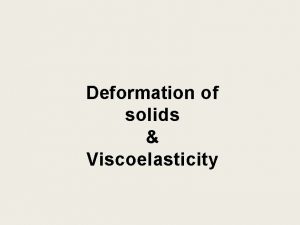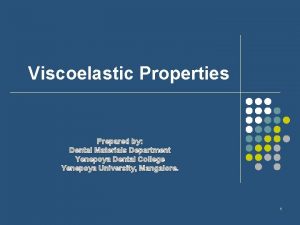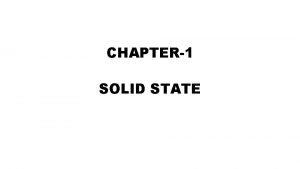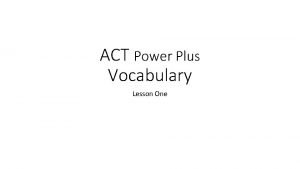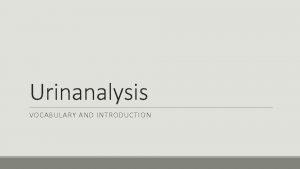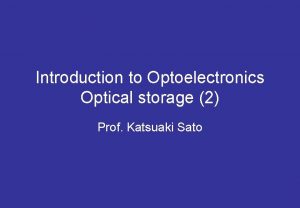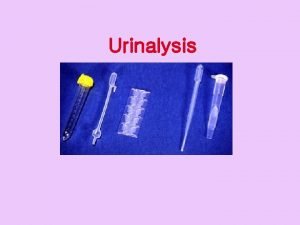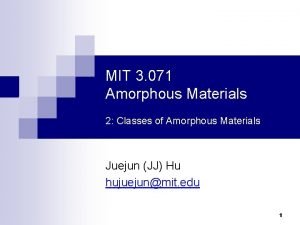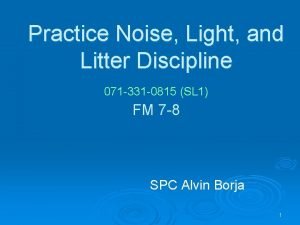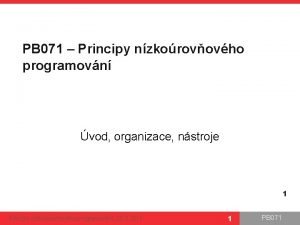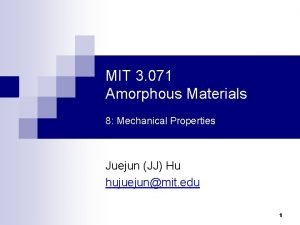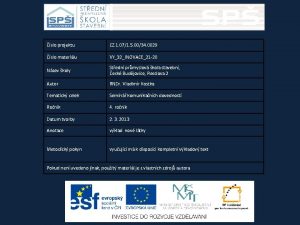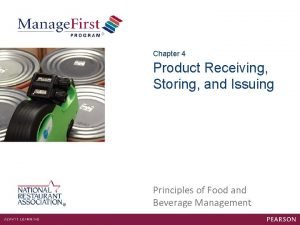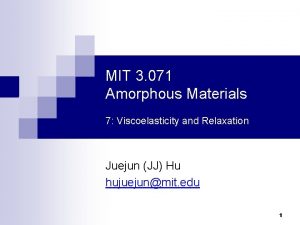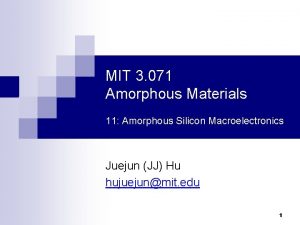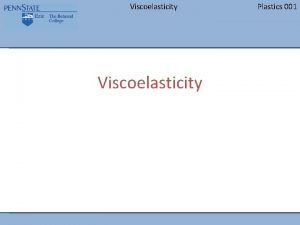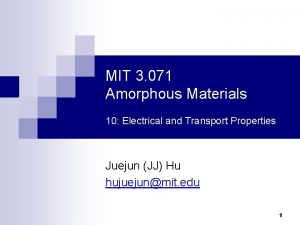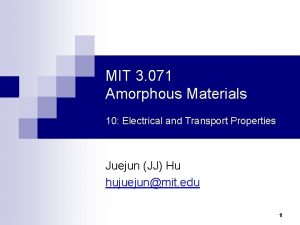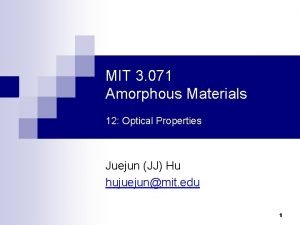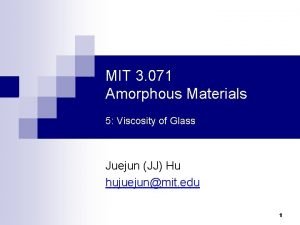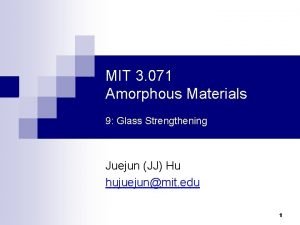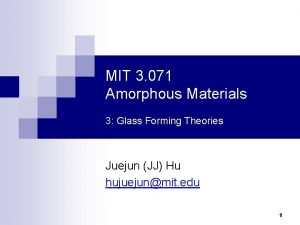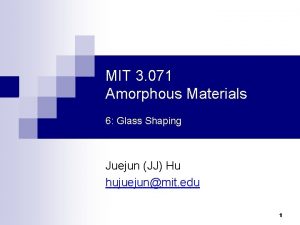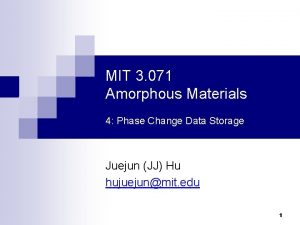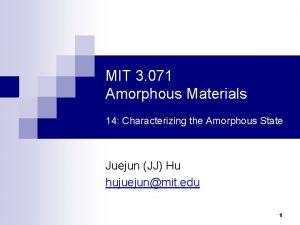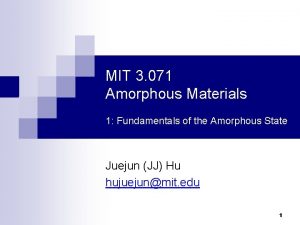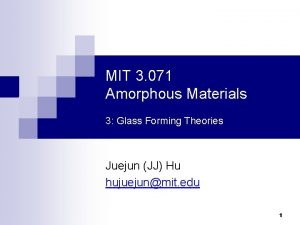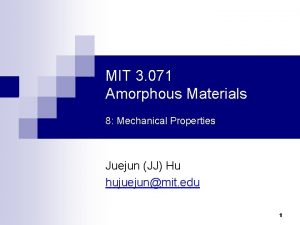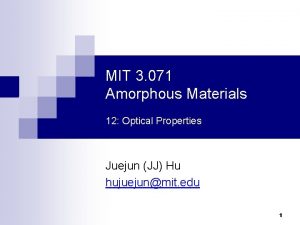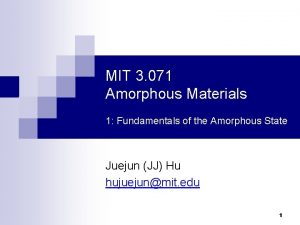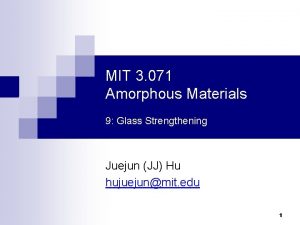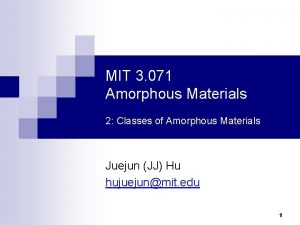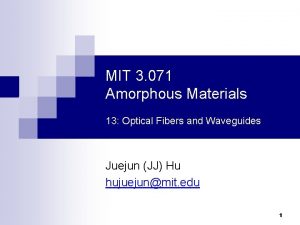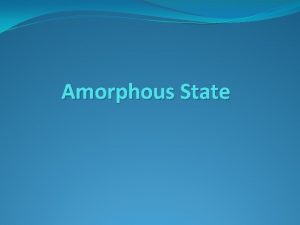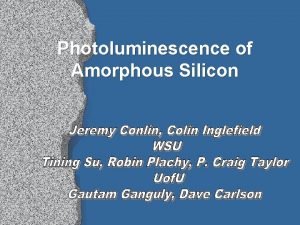MIT 3 071 Amorphous Materials 7 Viscoelasticity and


































- Slides: 34

MIT 3. 071 Amorphous Materials 7: Viscoelasticity and Relaxation Juejun (JJ) Hu hujuejun@mit. edu 1

After-class reading list n Fundamentals of Inorganic Glasses ¨ n Ch. 8, Ch. 13, Appendix A Introduction to Glass Science and Technology ¨ Ch. 9 (does not cover relaxation) 2

“The Nature of Glass Remains Anything but Clear” “What don’t we know? ” Science 309, 83 (2005). 3

“There are more theories of the glass transition than there are theorists who propose them. ” David Weitz, Harvard University

Is glass a solid or a viscous liquid? V Supercooled liquid Solid Elasticity instantaneous, transient Liquid Viscosity time-dependent, permanent Glass h : viscosity E : Young’s modulus (unit: Pa·s or Poise) G : shear modulus Tm T 5

Viscoelasticity: complex shear modulus n Consider a sinusoidally varying shear strain n Elastic response: n Viscous response: n In a general viscoelastic solid: G* : complex shear modulus Loss modulus Shear/storage modulus 6

Phenomenological models of viscoelastic materials n Elasticity: Hookean spring n Viscosity: Newtonian dashpot ü Models assume linear material response or infinitesimal stress ü Each dashpot element corresponds to a relaxation mechanism 7

The Maxwell element n Serial connection of a Hookean spring and a Newtonian dashpot n Total stress: n Total strain: 8

The Maxwell element n Constant stress (creep): n Constant strain (stress relaxation): Relaxation time 9

The Maxwell element n Oscillatory strain: 10

The Voigt-Kelvin element n n Parallel connection of a Hookean spring and a Newtonian dashpot n Total stress: n Total strain: n Constant stress: Oscillatory strain: 11

Generalized Maxwell model n For each Maxwell component: n Total stress: … 12

Generalized Maxwell model n Stress relaxation: n Prony series: … In real solids, a multitude of microscopic relaxation processes give rise to dispersion of relaxation time (stretched exponential) 13

Elastic, viscoelastic, and viscous responses Stress t Elastic strain Stress t Viscoelastic strain t t t Viscous strain t 14

Viscoelastic materials Mozzarella cheese Human skin Turbine blades Volcanic lava Naval ship propellers Memory foams 15

Boltzmann superposition principle n In the linear viscoelastic regime, the stress (strain) responses to successive strain (stress) stimuli are additive Strain t t t 2 t 1 Stress t t t 1 t t t 2 16

Boltzmann superposition principle n In the linear viscoelastic regime, the stress (strain) responses to successive strain (stress) stimuli are additive Strain t ü Viscoelastic response is history-dependent ü Relaxation function Y dictates time-domain response Stress t 17

V Structural relaxation in glass Glass transition Supercooled liquid Glassy state T Elastic regime All mechanical and thermal effects only affect atomic vibrations Viscoelastic regime Viscous regime Glass structure and properties are historydependent Structural changes are instantaneous: equilibrium state can be quickly reached Ergodicity breakdown 18

V Structural relaxation in glass Glass transition Supercooled liquid Glassy state T Elastic regime Viscoelastic regime Viscous regime Deborah number (DN): “… the mountains flowed before the Lord…” Prophetess Deborah (Judges 5: 5) 19

Comparing stress relaxation and structural relaxation V T n “Equilibrium” state ¨ Zero stress state n “Equilibrium” state ¨ Supercooled liquid state n Driving force ¨ Residual stress Relaxation kinetics ¨ Exponential decay with a single relaxation time ¨ Relaxation rate scales with driving force n Driving force ¨ Free volume Relaxation kinetics ¨ Exponential decay with a single relaxation time ¨ Relaxation rate scales with driving force n n 20

Free volume model of relaxation (first order kinetic model) n V Relaxation kinetics at constant temperature T n Temperature dependence of relaxation 21

Model predicted relaxation kinetics Cooling rate: 10 °C/s Slope: volume CTE of supercooled liquid Varying reheating rate 10 °C/s 1 °C/s 0. 1 °C/s 22

Model predicted relaxation kinetics Varying cooling rate Reheating rate: 1 °C/s 100 °C/s 1 °C/s Fictive temperature and glass structure are functions of cooling rate 23

Tool’s Fictive temperature theory V, H Supercooled liquid n Fictive temperature Tf : the temperature on the supercooled liquid curve at which the glass would find itself in equilibrium with the supercooled liquid state if brought suddenly to it n With increasing cooling rate: Increasing cooling rate 3 ¨ 2 1 Tf 1 < Tf 2 < Tf 3 n A glass state is fully described by thermodynamic parameters (T, P) and Tf n Glass properties are functions of temperature and Tf (structure) Tf 1 Tf 2 Tf 3 T 24

Tool’s Fictive temperature theory V, H Supercooled liquid Increasing cooling rate n Glass property change in the glass transition range consists of two components ¨ 3 Temperature-dependent property evolution without modifying glass structure Volume: 2 Enthalpy: 1 Tf 2 Tf 3 T ¨ Property change due to relaxation (Tf change) Volume: Enthalpy: 25

Tool’s Fictive temperature theory V, H Supercooled liquid Increasing cooling rate n Glass property change in the glass transition range consists of two components 3 2 1 Tf 2 Tf 3 T 26

Predicting glass structure evolution due to relaxation: Tool’s equation Consider a glass sample with Fictive temperature Tf P (V, H, S, etc. ) Take time derivative: Supercooled liquid Assume first-order relaxation: Glass Pg - Pe Tf - T T Tool’s equation Tf 27

Tool’s Fictive temperature theory Tool’s equation J. Am. Ceram. Soc. 29, 240 (1946) 28

Difficulties with Tool’s Tf theory n Ritland experiment: two groups of glass samples of identical composition were heat treated to obtain the same refractive index via two different routes ¨ Group A: kept at 530°C for 24 h ¨ Group B: cooled at 16°C/h through the glass transition range n Both groups were then placed in a furnace standing at 530°C and their refractive indices were measured as a function of heat treatment time n Glass structure cannot be fully characterized by the single parameter Tf J. Am. Ceram. Soc. 39, 403 (1956). 29

Explaining the Ritland experiment n t Structural relaxation in glass involves multiple structural entities and is characterized by a multitude of relaxation time scales Tool-Narayanaswamy-Moynihan (TNM) model 30

What is relaxation? Finally done with my 3. 071 project ! 31

Relaxation: return of a perturbed system into equilibrium n Examples ¨ Stress and strain relaxation in viscoelastic solids ¨ Free volume relaxation in glasses near Tg ¨ Glass structural relaxation (Tf change) n Time-dependent, occurs even after stimulus is removed n Debroah Number: ¨ DN >> 1: negligible relaxation due to sluggish kinetics ¨ DN << 1: system always in equilibrium ¨ DN ~ 1: system behavior dominated by relaxation 32

Modeling relaxation n n Relaxation rate Driving force Maxwellian relaxation models Boltzmann superposition principle in linear systems 33

Glass transition as a relaxation phenomenon: models n Free volume relaxation theory n Tool’s Fictive temperature theory n ¨ Uses a single parameter Tf to label glass structure ¨ Tool’s equation (of Tf relaxation) Structural relaxation in glass involves multiple structural entities and is characterized by a multitude of relaxation time scales ¨ The Ritland experiment 34
 Types of deformation of solids
Types of deformation of solids Example of viscoelastic material
Example of viscoelastic material Honors its atomic
Honors its atomic Lattice basis
Lattice basis Crystal solid and amorphous solid
Crystal solid and amorphous solid Crystalline solid and amorphous solid
Crystalline solid and amorphous solid Is cotton candy anisotropic
Is cotton candy anisotropic Amorphous urates in urine ph
Amorphous urates in urine ph Type of close packing in 2 dimension
Type of close packing in 2 dimension During the summit the factious ambassador caused
During the summit the factious ambassador caused Nocturia pronunciation
Nocturia pronunciation Amorphous disk mark
Amorphous disk mark Alkaptouria
Alkaptouria Mit
Mit Casts in urine
Casts in urine 071-com-0510
071-com-0510 Noise and light discipline
Noise and light discipline Pb 071
Pb 071 071-com-1001
071-com-1001 071 atm code
071 atm code 071-com-0804
071-com-0804 Pb 071
Pb 071 N 3^071
N 3^071 Employ hand grenades
Employ hand grenades 071-com-0029
071-com-0029 071-com-4407
071-com-4407 ?3305501049 0000 28|.|091 27|.|071 98|.|553 102|.|311 13`
?3305501049 0000 28|.|091 27|.|071 98|.|553 102|.|311 13` Go noodle cant stop the feeling
Go noodle cant stop the feeling Example of useful and harmful
Example of useful and harmful Man made materials
Man made materials Adapting and adopting materials
Adapting and adopting materials Direct materials budget with multiple materials
Direct materials budget with multiple materials Product issuing
Product issuing Tools materials needed
Tools materials needed Mit center for bits and atoms
Mit center for bits and atoms
